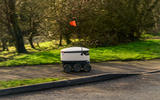The 1970s TV commercial for Smash, Cadbury’s instant mashed potato, famously featured a group of Martian robots mocking humans for mashing their spuds by hand. To peals of laughter, the chief robot concluded that humans “are clearly a most primitive people”. Spring forward 50 years and it’s tempting to think that, after the staff have shut up shop, the last-mile autonomous robots that now deliver instant mashed potato and other groceries to the people of Milton Keynes and Northampton enjoy an equally hearty chuckle at the expense of us humans and our efforts to develop autonomous passenger cars.
Test cars with level four (out of five) autonomy and a human inside for emergencies are only now feeling their way around public roads, while the little delivery robots have been confidently navigating the more anarchic pavements of Milton Keynes on their own for more than two years, albeit with a human in a control centre ready to intervene should they be required (they rarely are). What’s their secret, and could autonomous cars benefit from knowing it? To find out, I went to their newest location, Northampton, to see them in action.
I spotted my first robot trundling along a pavement a couple of miles from its home, the Co-op in Wootton Fields, a vast housing estate on the edge of the town. It cut a lonely figure – or, more accurately, box – no bigger than a microwave. Lonelier still when a couple walking the other way paid it no attention, even when, registering their approach, it moved aside to give them more room.

As I got closer to the Co-op, I saw more of them; some waiting at pedestrian crossings, another midway over a zebra crossing and others trundling along pavements to and from the shop. While young children thought the robots were fun, especially each time a machine thanked the Co-op assistant after they had loaded it with shopping (they can swallow up to 9kg of groceries), adult shoppers simply ignored them. Dogs sniffed them but, fortunately, none cocked a leg.




















Join the debate
Add your comment
Great idea and technology, although I wonder what the real customer experience will be like in the real world? The pavements in the UK are often littered with "presents" left by irresposible dog owners - does it dodge these or will it be a bit of a horrid way to have food arrive?
Quite an amazing thing, I wonder how it deals with different Weather conditions?,climates round the World, assuming they go global.